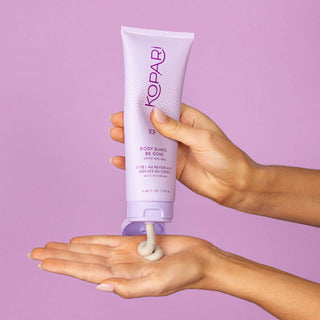Keratosis Pilaris (KP), is something that so many people struggle with but the majority of people just decide to live with it because they believe there is no way to get rid of it. This is far from the truth! We at Kopari are going to help you understand the cause of KP and the absolute best ways to get rid of it to unveil bright soft and bright skin!
What is Keratosis Pilaris?
Keratosis Pilaris manifests as small, rough bumps on the skin, typically found on the arms, legs, and occasionally on the cheeks. It affects a significant portion of the population, with estimates suggesting that up to 50% of individuals may experience KP at some point.
Causes of Keratosis Pilaris:
Understanding the causes of KP can help you better understand how to get rid of it on your skin. The primary cause of KP is the buildup of keratin in the hair follicles, which leads to the formation of bumps. Genetic predisposition and family history play a significant role in the development of KP. Additionally, factors such as dry skin and hormonal changes may exacerbate the condition.
Symptoms and Appearance of Keratosis Pilaris:
KP bumps are characterized by their small size, rough texture, and occasional redness or inflammation. The affected areas may feel dry and rough to the touch, and some individuals may experience itching or irritation.
Types of Keratosis Pilaris:
There are different subtypes of KP that vary in appearance and affected areas:
Classic KP: Small, rough bumps without inflammation or irritation.
KP Rubra: Red, inflamed bumps that may cause a burning or itching sensation.
KP Rubra Faceii: KP localized to the cheeks, often mistaken for acne.
Options for Keratosis Pilaris:
Managing KP involves adopting specific options, including:
Gentle exfoliation: Regularly removing dead skin cells to unclog pores and reduce bumpiness.
Moisturizing: Hydrating the skin to minimize dryness and improve the texture.
Additionally, specific products such as topical creams or lotions containing exfoliating ingredients like AHAs or BHAs are great options to combat KP.
Lifestyle Factors and KP:
Several lifestyle factors can influence KP symptoms. Diet may play a role, and some individuals find that certain foods or nutrients can trigger or aggravate KP. Climate conditions, such as dry or cold weather, can also affect KP. Additionally, stress levels have been linked to KP flare-ups, so managing stress through relaxation techniques or counseling may be beneficial. There can be so many uncontrollable factors, that is why we are here to give you an understanding about how to combat KP in every way you can!
Understanding the causes, symptoms, and management options for Keratosis Pilaris empowers individuals to manage this common skin condition effectively. With patience, and consistency in skincare, you can minimize the appearance of KP and achieve smoother, healthier-looking skin.
What is Keratosis Pilaris?
Keratosis Pilaris manifests as small, rough bumps on the skin, typically found on the arms, legs, and occasionally on the cheeks. It affects a significant portion of the population, with estimates suggesting that up to 50% of individuals may experience KP at some point.
Causes of Keratosis Pilaris:
Understanding the causes of KP can help you better understand how to get rid of it on your skin. The primary cause of KP is the buildup of keratin in the hair follicles, which leads to the formation of bumps. Genetic predisposition and family history play a significant role in the development of KP. Additionally, factors such as dry skin and hormonal changes may exacerbate the condition.
Symptoms and Appearance of Keratosis Pilaris:
KP bumps are characterized by their small size, rough texture, and occasional redness or inflammation. The affected areas may feel dry and rough to the touch, and some individuals may experience itching or irritation.
Types of Keratosis Pilaris:
There are different subtypes of KP that vary in appearance and affected areas:
Classic KP: Small, rough bumps without inflammation or irritation.
KP Rubra: Red, inflamed bumps that may cause a burning or itching sensation.
KP Rubra Faceii: KP localized to the cheeks, often mistaken for acne.
Options for Keratosis Pilaris:
Managing KP involves adopting specific options, including:
Gentle exfoliation: Regularly removing dead skin cells to unclog pores and reduce bumpiness.
Moisturizing: Hydrating the skin to minimize dryness and improve the texture.
Additionally, specific products such as topical creams or lotions containing exfoliating ingredients like AHAs or BHAs are great options to combat KP.
Lifestyle Factors and KP:
Several lifestyle factors can influence KP symptoms. Diet may play a role, and some individuals find that certain foods or nutrients can trigger or aggravate KP. Climate conditions, such as dry or cold weather, can also affect KP. Additionally, stress levels have been linked to KP flare-ups, so managing stress through relaxation techniques or counseling may be beneficial. There can be so many uncontrollable factors, that is why we are here to give you an understanding about how to combat KP in every way you can!
Understanding the causes, symptoms, and management options for Keratosis Pilaris empowers individuals to manage this common skin condition effectively. With patience, and consistency in skincare, you can minimize the appearance of KP and achieve smoother, healthier-looking skin.


